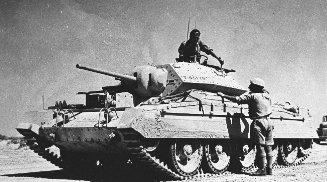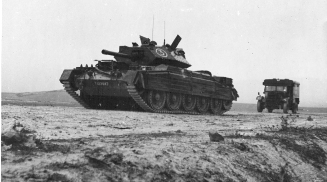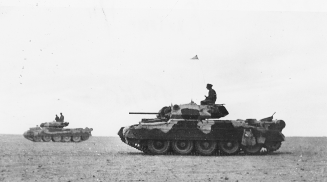
The Crusader was the mainstay of British tank units in North Africa in 1941 and 1942. It was valued for its mobility and relative speed, but, in common with other British tanks of the time, lacked a main gun capable of meeting the opposition on equal terms.
The Crusader was designed by Nuffield as an independent response to the General Staff specification A15 for a ‘Cruiser’ tank. According to British tank philosophy of the time, these were intended to be highly mobile vehicles whose role would equate to that of the cavalry in earlier times. As a result they were quick, but relatively lightly armed and armoured.
Perhaps the most noteworthy part of the Crusader is its suspension, built according to a system invented by the American engineer Walter Christie in the 1930s. Basically this allowed for longer travel of the roadwheels and relatively soft springing. All this enhanced the cross country performance of the tank and fitted well with the ‘Cruiser’ role. This system continued in use up to the Cromwell – the last ‘Cruiser’, and was very favoured by the Russians, finding its most widespread use in the legendary T34.



Perhaps the most noteworthy part of the Crusader is its suspension, built according to a system invented by the American engineer Walter Christie in the 1930s. Basically this allowed for longer travel of the roadwheels and relatively soft springing. All this enhanced the cross country performance of the tank and fitted well with the ‘Cruiser’ role. This system continued in use up to the Cromwell – the last ‘Cruiser’, and was very favoured by the Russians, finding its most widespread use in the legendary T34.
Crusaders first arrived in North Africa in May 1941, and before they got into action, they already suffered from the continuing problem of British tanks – poor reliability. This meant that they did not go into action until June. The limitations of its 2 pounder gun also began to be noticed. Although adequate against the Panzer III, it was outranged and outclassed by the 75mm gun of the Panzer IV. Along with the upgrading of armament in other contemporary tanks, the Crusader was modified to take the 6 Pounder gun, and the first of the new derivatives took part in the battle of El Alamein in October 1942.
Although being gradually supplanted by, first, the M3 Grant and latterly the Sherman, the Crusader continued to soldier on through North Africa into 1943. The basically sound chassis found further use in other forms – as Anti Aircraft tanks, artillery tractors and engineer vehicles. It was the product of hurried development under the pressures of war and a flawed philosophy. Its agility was prized by its crews, but it could never outgrow the in- built limitations of its design.


